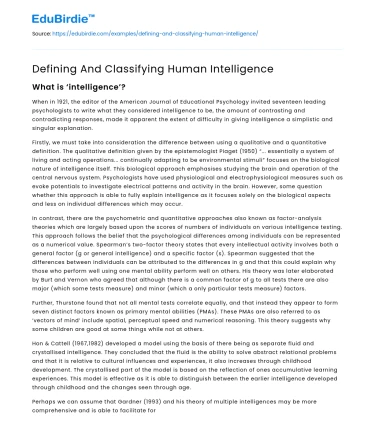What is ‘intelligence’?
When in 1921, the editor of the American Journal of Educational Psychology invited seventeen leading psychologists to write what they considered intelligence to be, the amount of contrasting and contradicting responses, made it apparent the extent of difficulty in giving intelligence a simplistic and singular explanation.
Firstly, we must take into consideration the difference between using a qualitative and a quantitative definition. The qualitative definition given by the epistemologist Piaget (1950) “... essentially a system of living and acting operations... continually adapting to be environmental stimuli” focuses on the biological nature of intelligence itself. This biological approach emphasises studying the brain and operation of the central nervous system. Psychologists have used physiological and electrophysiological measures such as evoke potentials to investigate electrical patterns and activity in the brain. However, some question whether this approach is able to fully explain intelligence as it focuses solely on the biological aspects and less on individual differences which may occur.
Save your time!
We can take care of your essay
- Proper editing and formatting
- Free revision, title page, and bibliography
- Flexible prices and money-back guarantee
In contrast, there are the psychometric and quantitative approaches also known as factor-analysis theories which are largely based upon the scores of numbers of individuals on various intelligence testing. This approach follows the belief that the psychological differences among individuals can be represented as a numerical value. Spearman’s two-factor theory states that every intellectual activity involves both a general factor (g or general intelligence) and a specific factor (s). Spearman suggested that the differences between individuals can be attributed to the differences in g and that this could explain why those who perform well using one mental ability perform well on others. His theory was later elaborated by Burt and Vernon who agreed that although there is a common factor of g to all tests there are also major (which some tests measure) and minor (which a only particular tests measure) factors.
Further, Thurstone found that not all mental tests correlate equally, and that instead they appear to form seven distinct factors known as primary mental abilities (PMAs). These PMAs are also referred to as ‘vectors of mind’ include spatial, perceptual speed and numerical reasoning. This theory suggests why some children are good at some things while not at others.
Hon & Cattell (1967,1982) developed a model using the basis of there being as separate fluid and crystallised intelligence. They concluded that the fluid is the ability to solve abstract relational problems and that it is relative to cultural influences and experiences, it also increases through childhood development. The crystallised part of the model is based on the reflection of ones accumulative learning experiences. This model is effective as it is able to distinguish between the earlier intelligence developed through childhood and the changes seen through age.
Perhaps we can assume that Gardner (1993) and his theory of multiple intelligences may be more comprehensive and is able to facilitate for many instances of intelligence. He identified eight different types of intelligence and evidence for this multiple intelligence theory can also be seen through the localisation of brain function, each intelligence is believed to reside in a separate area of the brain and we may be able to understand more thoroughly when studying brain damaged patients.
Intelligence quotient (IQ) tests are also frequently used to measure ones intelligence however, as Boring (1923) stated ‘Intelligence is what our intelligence tests measure’ this suggests that even the researchers and psychologists responsible for devising these tests are not fully aware of what they are actually testing for. Although intelligence has been considered to be a psychological concept, do these tests producing numerical values only take into account the individuals intelligence statistically? (Gross, 2005). On top of this, how can we compare IQ scores through the use of multiple tests where standard deviation between each is so great? (Gross). So perhaps these IQ test cannot be correlated to an individuals intelligence but simply the score on each separate test.
In conclusion, the breadth and depth of intelligence is incredibly expansive and it is a topic which many consider to be the ‘holy grail’ of psychology. The question of ones intelligence has not only kept the influential psychologists of Spearman and Gardner awake at night but also the many non-psychologists who have wondered whether they themselves are intelligent. Perchance we can speculate that rather than their being a basic definition confined to only one psychological area that instead the intelligence of an individual can be easier explained through research focusing on the biological, quantitative and cognitive aspects of psychology which through working together could help us to reach a more conclusive and precise explanation. Could we possibly go as far as to suggest that there is to some extent an ignorance in only focusing on one area? And even more so with the extensive knowledge of how complex and diverse humans and our nature is?






 Stuck on your essay?
Stuck on your essay?

